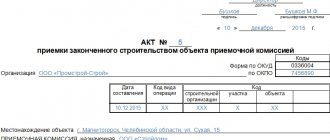Issues discussed in the material:
- What are the general rules for accepting goods
- How to accept goods in terms of quantity and quality
- What documents must be present when accepting goods?
- What to do if the quantity of goods at receipt does not match
One of the most important issues in the operation of a retail facility is the rules for accepting goods. The supplied products may be defective, expired, or have other characteristics that differ from the information in the attached documentation. Therefore, warehouse workers must follow the rules for accepting goods. This allows you to protect yourself from mistakes and your business from loss of profit.
Examination: features of the conduct
There are three types of examination:
- examination of documentation;
- examination of the results of contract implementation by a third party;
- internal examination of the customer himself.
During the examination, it is necessary to check whether the procurement object meets the terms of the contract, and also pay attention to the quality and volume of goods supplied, services provided, and work performed.
Make sure that:
- the object of purchase has no defects;
- there is no damage to the purchased item (including packaging);
- the product lot is homogeneous;
- the expiration date has not expired;
- there are the necessary certificates.
Take into account the expert opinion when deciding whether to accept the results of the contract execution or not (Parts 3 and 7 of Article 94 of Federal Law No. 44-FZ)
Mandatory terms of the contract for the provision of expert services include:
- subject of examination;
- authority of the expert;
- conditions for admission to the examination (qualification of the expert and timing of the examination). The timing of the examination must correspond to the delivery time of the goods.
If an external examination reveals a violation of the terms of the contract, the customer is obliged to be guided by the conclusion of this examination and take measures provided for by law, up to and including unilateral termination of the contract. If an external examination reveals violations of the terms of the contract, the customer must decide what measures it will take against the supplier for violating the terms of delivery.
If any discrepancies are found during acceptance, you need to proceed to re-acceptance. If, as a result of the initial acceptance of goods, violations were identified, it is necessary to invite a representative of the supplier for re-acceptance by sending him a notification.
Invitation to inspect the goods
If an authorized representative of the supplier is not present at acceptance, the customer must send an invitation to the supplier to inspect the goods no later than 24 hours after discovery of defects.
The invitation contains the following information:
- name of the product, date of its shipment;
- numbers of shipping documents or acceptance documents;
- the quantity of damaged goods and its value, the nature of the damage;
- condition of the fillings;
- the time for which the joint two-way acceptance is scheduled;
- acceptance address;
- Contact details.
The invitation to participate in the re-acceptance of goods shall indicate:
- place and time;
- composition of the commission;
- information about low-quality products.
Posting
To control sales, the store records accepted goods and their quantity, and then removes those sold. To do this, you will need a commodity accounting system, for example Kontur.Market. After acceptance, the goods need to be capitalized - create a new product in the database or change the quantity of an existing one. In the commodity accounting system, each product is described by several attributes: name, price, type of product, VAT amount and others.
If there are a lot of goods, a 2D barcode scanner will help simplify the process of posting goods: the employee does not enter the names of the goods, but scans the barcodes. The product appears on the store’s balance sheet - it can be sold and accounted for.
Specifics of readmission
The fact of repeated acceptance must be recorded in the act in the TORG-2 form. Those goods for which no discrepancies in quantity and quality have been established are not listed in the acts. It is enough to make a note in the act: “There are no discrepancies regarding other inventory items.”
The fact of repeated acceptance is recorded in the invoice in the TORG-2 form. If the products are of foreign origin, then the TORG-3 form is used. Goods whose quality and quantity claims have not been established are not mentioned in this invoice. A note is made that there are no complaints about quality and quantity for other goods.
In what form should it be compiled?
The unified form of the act of acceptance and transfer of material assets has not been approved; the organization is developing it independently. The form adopted by the organization should be approved in the accounting policy for accounting purposes based on the recommendations of the Ministry of Finance set out in Information No. PZ-10/2012. The form may be an integral part of the contract, an appendix to it, in which case it is binding on each of the parties, regardless of the form approved in its accounting policy.
Acceptance certificate
The act is drawn up in at least two copies - for the supplier and the buyer. It is stitched, sealed and signed by all members of the commission: the buyer, representatives of the supplier or manufacturer, and the expert. Photos of the act are sent to the rest of the commission members. If an acceptance participant fails to appear or a commission member refuses to sign the document, a note is made in the acceptance certificate.
A report is drawn up for everyone participating in the acceptance of samples, so that all participants can see that the product is marked with certain words and letters, that the packaging is in one condition or another, and that the product was found in one quantity or another.
All participants in the acceptance of goods retain the same documents with the signatures of all participants in the acceptance. If one of the commission members signs the act, a note about this is made in the act itself.
In the accompanying documents (railway waybill, waybill, invoice, invoice, etc.) for the received goods, a note is made about discrepancies discovered when drawing up the report. The act approved by the manager, together with accompanying documents, is transferred to the accounting department of the buyer’s organization. The accounting department calculates the amount of the claim.
In the accompanying documents, a note is made that after the initial acceptance, repeated acceptance took place and an act was drawn up in the TORG-12 form or a sampling act was carried out.
At the initial acceptance stage, the necessary marks must be placed on the invoice about all suspicious points that were detected. Often the invoice does not indicate the batch number of the delivered goods or its full range and there is no direct confirmation that, for example, the pipe was supplied along with a specific invoice, quality certificate and certificate of conformity.
The batch number, quality certificate number or certificate of conformity number can be manually entered into the invoice upon initial acceptance of the goods.
How to write a letter of claim
The buyer draws up and sends a letter of claim or a decision on unilateral termination of the contract to the supplier along with a copy of the incoming inspection report and the TORG-2 form or an expert’s report (if an expert was involved).
These documents must indicate correct comments on the quality or quantity of the product and suggest ways to resolve the problem. After the act in form TORG-2 or another document has established the quantity of goods that does not meet the requirements of the contract, the buyer draws up and sends a letter of claim addressed to the supplier. The letter must list which products have complaints about quality and quantity and what the supplier must do to eliminate these shortcomings.
The claim letter and decision must include:
- name of the delivery document;
- date and place of document preparation;
- name of the organization on behalf of which the document was drawn up;
- a link to the supply agreement and the delivered goods (name, quantity, price, assortment, batch);
- a list of requirements to the supplier (refund of the amount paid, replacement of goods, elimination of deficiencies) to resolve the problem.
If you believe that it is impossible to eliminate the shortcomings, you can issue a unilateral refusal to perform the contract.
Alternative documents
The rule for applying the APP allows for its replacement with a consignment note, but then the document must display the following data:
- about the parties entering into the agreement;
- about the product;
- about the date of signing the paper.
But it is impossible to replace the invoice with the main document (purchase and sale agreement).
Drawing up an APP is necessary if there are complaints about the characteristics of inventory items and they need to be recorded, or if everything is in order, but this also needs to be displayed.
What is unilateral termination of a contract?
Unilateral termination of a contract is a procedure that starts from the moment you send notice to the supplier of your intention to terminate the contract. With the help of a complaint, you can indicate your intention to obtain a fine from the supplier, but penalties provided for in the contract do not motivate the supplier as much as unilateral termination.
The unilateral termination procedure assumes that:
- the contract must necessarily indicate the terms of liability of the customer and supplier for non-fulfillment or improper fulfillment of the contract (Part 4, Article 34 of Federal Law No. 44-FZ), penalties and fines for violation of payment terms (Part 5, Article 34 of Federal Law No. 44 -FZ);
- if some conditions and obligations upon termination of a contract are not described in the procurement law, the Civil Code and federal laws apply - to the extent that they do not contradict 44-FZ;
- If inconsistencies are found during the examination, it is necessary to draw up a report of the identified violations.
How is a decision made to unilaterally refuse to perform a contract:
- Within 3 working days from the date of the decision to unilaterally terminate the contract, the customer places it in the Unified Information System and sends it to the supplier by registered mail with return receipt requested.
- If within 10 days the contractor manages to correct the violations, then the customer is obliged to cancel the decision on unilateral refusal to fulfill the contract that has not entered into force (Part 14, Article 95 of Federal Law No. 44-FZ).
- The customer’s decision to unilaterally refuse to fulfill the contract comes into force, and the contract is considered terminated 10 days from the date the customer notifies the supplier of the unilateral refusal to fulfill the contract (Part 13, Article 95 of Federal Law No. 44-FZ).
The procedure for unilateral termination of a contract is prescribed in Art. 95 44-FZ. It lists all situations where the customer has the right to terminate the contract unilaterally. The main condition is the delivery of goods that do not comply with the conditions of the procurement documentation, or the supplier’s non-compliance with the requirements set forth in the procurement documentation.
The contract must specify the terms of liability of the customer and supplier for failure to fulfill the contract. If some conditions and obligations are not specified in the contract, the Civil Code applies - in those parts where it does not contradict 44-FZ.
If violations are identified during the examination of the goods, it is necessary to draw up a report on the violations identified. After you have sent a decision on unilateral refusal to fulfill the contract to the supplier, it must be placed in the Unified Information System.
The supplier will have 10 days to eliminate any identified deficiencies. He can either replace the product or write a reasonable refutation of your claims. If the supplier does not take any measures within the established period and does not eliminate the identified violations, the contract is considered terminated, and you have the right to announce a new purchase using a simplified procedure in a shortened time frame.
Supply plan
As a rule, the purchasing department interacts with a certain number of suppliers and has the ability to record and accumulate information about the duration of order processing and delivery of ordered products by suppliers. Having data on the duration of the order cycle, you can plan the date of receipt of goods at the warehouse. And knowing the maximum capacity of the warehouse for receiving goods per shift (or per day), it is possible to ensure a relatively uniform load on the warehouse with incoming goods from several suppliers. To do this, it is necessary to draw up a plan for placing orders with suppliers (and, accordingly, for supplying goods to the warehouse), in which the daily volume of incoming cargo will not exceed 75–80% of the warehouse’s maximum receiving capacity.
Obviously, the supply plan cannot be executed with absolute accuracy. Deviation of the actual delivery date from the planned one may occur for various reasons related to the reliability of suppliers and transport companies. However, in any case, the warehouse operation will be more uniform, and warehouse resources will be used more efficiently.
Implementation of planning can be carried out using both the functions of the corporate information system and simpler tools (MS Excel or MS Project).
A simplified example of drawing up and adjusting a schedule for the delivery of goods to a warehouse is presented in Figures 1 and 2.
At the first stage, data on the order cycle and supply volume are entered into the table. The sum of the volume of deliveries to the warehouse is compared with the effective capacity of the receiving department. The supplier's order date is then moved so that the total volume of deliveries to the warehouse does not exceed the warehouse's capacity and that deliveries occur on business days.
Rice. 1 Initial delivery schedule
Fig.2. Adjusted delivery schedule
Algorithm of actions when identifying violations of contract terms
The customer is obliged to make a decision on unilateral refusal to fulfill the contract if during the execution of the contract it is established that the supplied goods do not meet the requirements that were established by the notice and procurement documentation (clause 15 of article 95 of Federal Law No. 44-FZ).
44-FZ obliges the customer to make a decision on unilateral refusal to fulfill the contract if the supplied goods do not meet the requirements of the auction documentation, and gives the supplier 10 days to eliminate the identified violations.
If the supplier repeatedly delivers goods of inadequate quality, he can no longer eliminate the defects. If you repeatedly identify these violations, within 10 days after notifying the supplier of a unilateral refusal to fulfill the contract, the contract is considered terminated.
44-FZ does not oblige the customer to draw up claims or demands for elimination of deficiencies. You can immediately send a notice of unilateral termination of the contract, obliging the supplier to eliminate the identified violations as soon as possible. This allows you to quickly solve the problem of low-quality goods.
The customer is obliged to cancel the decision on unilateral refusal to perform the contract that has not entered into force if, within 10 days from the date of notification, the violation of the terms of the contract that served as the basis for making this decision is eliminated and the customer is compensated for the costs of the examination.
This rule does not apply in the event of a repeated violation by the contractor of the terms of the contract, which, in accordance with the Civil Code, are the basis for the customer’s unilateral refusal to fulfill the contract.
The customer is obliged to cancel the decision on unilateral refusal to perform the contract that has not entered into force if the supplier has eliminated the identified violations. This is beneficial for everyone: the customer receives his goods, the supplier avoids sanctions and receives payment under the contract on time.
How does restriction of competition manifest itself?
When preparing procurement documents, care must be taken to ensure the quality of goods, but it is important not to overdo it or limit competition.
What violations do customers commit?
- The placement of unreadable and uncopiable materials is regarded as a restriction of competition. Even the WinRAR archiver is a paid program, so placing an archive in the .rar format is not entirely correct.
- All auction documentation must be placed in the Unified Information System in full. If some document is missing, a potential participant can complain to the FAS.
- In the technical specifications, the requirement to supply goods from a certain manufacturer must be accompanied by the words “or equivalent.” If there is no such amendment, the parameters to which the supplied product must comply must be clearly stated.
- It is impossible to establish a requirement that the supplier is not in the Register of Unscrupulous Suppliers. No such registry exists. There is a separate register of unscrupulous suppliers under 44-FZ and 223-FZ. It is impossible to demand that a participant not be on the register under 223-FZ if you are conducting a selection within the framework of 44-FZ and vice versa.
- It is unlawful to require delivery experience in a certain territory. All requirements related to the supplier’s experience in participating in auctions and government procurement are specified in 44-FZ and 223-FZ.
- It is prohibited to establish requirements that limit the circle of participants and do not confirm the quality of the work or services they perform.
- It is impossible to establish a requirement for ownership of the equipment, or that the work must be performed only on its own, without the involvement of subcontractors, or other restrictions that do not affect the quality of the work performed.
- It is incorrect to place requirements on the conformity of a product with specifications that are not publicly available, therefore membership in a certain self-regulatory organization cannot be required.
- The requirement to have a license for a certain type of activity must be enshrined in law and cannot be imposed at the request of the customer.
- Requiring only the manufacturer of the product to bid limits competition and discourages intermediaries who could potentially bid.









